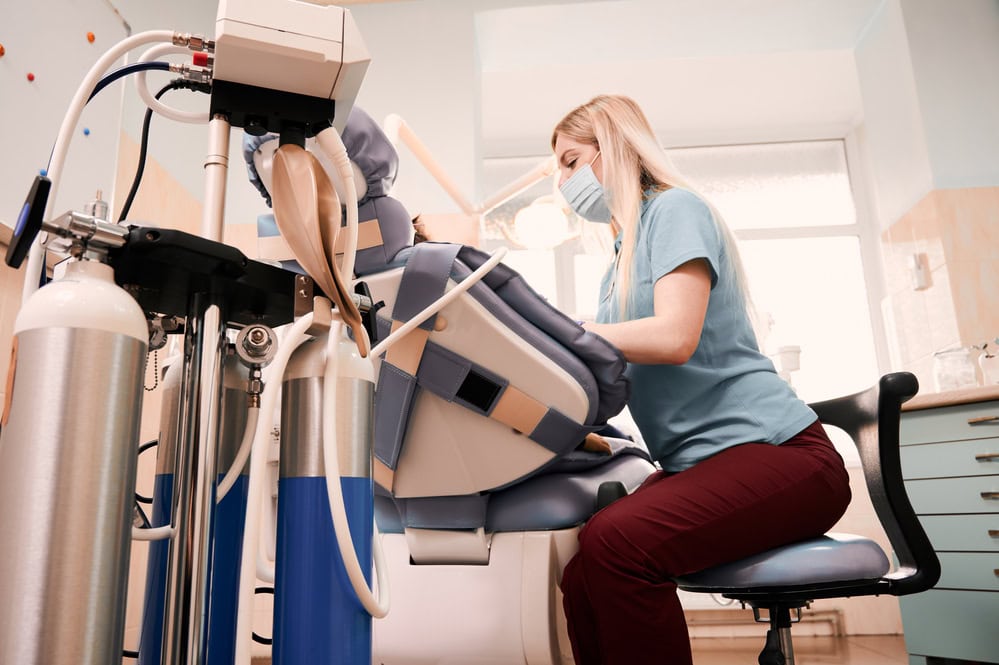A brighter, whiter smile is like a ray of sunshine, radiating warmth and confidence. Teeth whitening is a process used to lighten the natural colour of teeth, often to enhance their appearance.
This article will discuss the types, benefits, best candidates, preparation, procedure, aftercare, results, and risks of teeth whitening to help those wishing to bring out the beauty in their smile.
Types of Whitening
Nowadays, there are a variety of whitening methods available to help individuals achieve brighter smiles. Tooth whitening, or teeth bleaching, is a safe and effective way to brighten discoloured teeth.
One of the most common types of whitening is done by a dental professional, which uses a special gel made up of Carbamide Peroxide or Hydrogen Peroxide. This gel is applied to the surface of the teeth, and the Tooth Enamel is broken down, thus allowing the whitening agent to penetrate the enamel and remove any discolouration.
For those who have sensitive teeth or gum irritation, there are a few options available. One is to use a toothpaste that contains mild abrasives or whitening agents. These toothpastes help to remove surface stains and can provide a brighter smile without the need for special dental procedures.
Another option is to use a special whitening tray that is made by a dental professional. The tray is filled with a special whitening gel and placed over the teeth for up to 30 minutes a day.
No matter which whitening method is chosen, the results can be dramatic and long-lasting. Professional teeth whitening can help to prevent the buildup of plaque and tooth decay and can give an individual a brighter, more confident smile. Whitening products and treatments are available over-the-counter, and those that are administered by a dental professional can provide more dramatic results.
Benefits of Whitening
In addition to providing a brighter, more confident smile, professional whitening can also help to prevent the buildup of plaque and tooth decay. Beyond the aesthetic benefits, teeth whitening is an important part of maintaining good oral hygiene. By removing surface stains and discolouration, this effective cosmetic treatment can reduce the risk of gum disease and other dental issues. People who suffer from tooth sensitivity may also find relief after undergoing a teeth whitening process.
Teeth whitening is a safe procedure that is available in a variety of forms, such as bleaching solutions and professional whitening treatments. The type of whitening used will depend on the individual’s oral health and the desired outcome. Regardless of the method chosen, this cosmetic treatment can be an effective way to give an individual a whiter and brighter smile.
The benefits of teeth whitening go beyond just aesthetics. This treatment can often be done quickly and safely with minimal to no discomfort. It can also help to improve overall oral health by reducing the risk of gum disease and other dental issues. Furthermore, it can be a cost-effective way to improve an individual’s overall confidence and self-esteem.
At the end of the day, teeth whitening can be an affordable and safe solution for those looking for a brighter, whiter smile. Professional teeth whitening treatments can provide long-lasting results while also helping to prevent the buildup of plaque and tooth decay. With the help of a qualified dentist, individuals can enjoy the many benefits of teeth whitening and achieve a healthier, more confident smile.
Best Candidates for Whitening
Generally, the best candidate for professional teeth whitening is a person with healthy gums and natural teeth who has tooth discolouration due to aging, dietary habits, tobacco use, or other extrinsic factors. Dental practitioners typically recommend professional bleaching for individuals who are seeking to whiten their teeth several shades lighter.
For those with more severe discolouration, office treatments or professional whitening trays are the best options. Professional whitening trays are custom-fitted to each individual and are filled with a whitening gel that the patient will wear for several hours. The benefits of this type of whitening are that it is more effective and longer lasting compared to over-the-counter tooth whitening products.
When considering teeth whitening, it is important to consult with a professional dental practitioner to make sure that it is a safe and appropriate option for you. They can assess the condition of your teeth, recommend the best whitening product or treatment, and provide instructions on proper use.
With the help of a professional, you can achieve the beautiful white teeth you desire.
Preparation
Before beginning any teeth whitening procedure, it is important to prepare to ensure both safety and effectiveness properly. It is important to realize that not all teeth are suitable candidates for whitening, especially those with dental restorations such as crowns, bridges, and fillings. This is because the whitening procedure will not change the colour of the dental restorations, and these will remain the same colour while the surrounding natural teeth whiten. Additionally, any intrinsic staining that is present, such as yellowish colour due to a root canal treatment, is not corrected by whitening. Furthermore, any extrinsic tooth stains, such as those caused by smoking or drinking coffee or tea, may respond differently to whitening depending on the concentration of hydrogen peroxide used.
When whitening, it is important to use the whitening product prescribed by your dentist, as this will be tailored to your tooth colour and the amount of discolouration. Using a product that is too strong may result in over-whitening, creating a tooth colour that is unnaturally white and bright. The aim of a whitening procedure is to achieve a brighter shade of teeth that is still natural-looking.
It is also important to ensure that your teeth and gums are healthy before whitening. If there is any inflammation or infection present, such as gingivitis or periodontitis, whitening should not be done until the oral health issue is addressed and resolved.
Procedure
Building on the importance of preparation, the next step is to understand the procedure of teeth whitening. Teeth whitening is a safe and effective way to achieve a perfect smile for anyone who has yellow or stained teeth. The procedure is usually performed at a dental office, where the dentist applies a hydrogen peroxide gel to the teeth, which then penetrates the enamel to break down the discolouration. The effects of teeth whitening can last up to two to three years, depending on lifestyle habits, such as smoking and drinking coffee or tea.
In order to determine if a person is a candidate for teeth whitening, the dentist will evaluate the teeth and gums and take a comprehensive medical history. After a few initial tests, the dentist will also examine the teeth to determine the number of shades whiter the teeth can become. Once the dentist has determined the whitening solution is safe, he or she will apply the whitening product to the teeth and then rinse the mouth with water.
The procedure can take anywhere from thirty minutes to an hour for in-office whitening or several days for a take-home whitening kit. The dentist will usually provide instructions on how to care for the teeth after the whitening procedure, such as avoiding smoking and foods that can cause staining.
Aftercare
Once the teeth whitening procedure is complete, it is important to follow the dentist’s aftercare instructions in order to maintain the desired results. After a dental hygienist or dentist performs a chair or counter treatment, it is essential to adhere to the aftercare protocol. This may include avoiding concentrations of hydrogen peroxide, sugary foods and drinks, coloured foods, and other items that may cause tooth discolouration.
Good oral hygiene practices are also essential for maintaining a healthy and white smile. Visiting a dental practice regularly for checkups and cleanings is highly recommended. It is also important to use tooth whitening methods only as directed by a dentist or dental hygienist, as overuse of the treatment procedures can damage the teeth.
Results
Following the aftercare instructions and commitment to good oral hygiene, many patients experience positive results with their teeth whitening treatment. Generally, teeth whitening procedures are safe and effective for most individuals, although pregnant women and those with certain medical conditions should avoid cosmetic procedures such as teeth whitening. The combination of professional dental services and at-home products can be used to reduce extrinsic staining and brighten the appearance of the teeth.
The results of teeth whitening vary for each patient and are often dependent on the type of staining that is present. Some people may experience better results with in-office tooth whitening, while others may have better results with take-home products such as whitening strips and trays. Internal bleaching, also known as chair teeth whitening, is another option that is used to treat discolouration that is caused by tooth trauma.
For those who have achieved their desired results with teeth whitening, it is important to maintain the whiteness of the teeth. Good oral hygiene is essential for maintaining the brightness of the teeth, and it is important to avoid consuming cold foods or drinks that can cause staining. In addition, individuals should consider using counter teeth whitening products to maintain their results.
Risks
Although teeth whitening is generally safe and effective for most individuals, there are some risks associated with the procedure that patients should be aware of. With any effective treatment, there is always the potential for risks, especially for those with baby teeth, as the bleaching solution may cause damage in connection with the permanent teeth.
Blue light is also a common risk during the teeth whitening process as it can cause discolored teeth and gingival irritation. Additionally, there is a risk of chemical burns from the layer of peroxide gel on the teeth.
When considering teeth whitening, it is important to be aware of the potential adverse effects. Common side effects are tooth sensitivity, gingival irritation, and risk of chemical burns. In some cases, there can also be chemical degradation of the periodontal tissue or restorative materials. Another risk to be aware of is an increase in surface roughness, which can be especially prevalent when using in-chair whitening dental treatments or aggressive bleaching.
The concentration of carbamide peroxide, or the percentage of hydrogen peroxide, can have an impact on the risk of tooth sensitivity. Custom tray-delivered hydrogen peroxide products are generally considered to be safer than strip products, as the tray helps to keep the bleach on the teeth’ surface. The improvement in shade colour is often determined by shade guides that compare the initial shade to the target shade. Additionally, a light-cured protective layer is applied to the teeth before the whitening process to protect the conditions of restorations.
It is important to be aware of the risks of unlawful tooth whitening services. These services often utilize agents during tooth bleaching that have a higher hydrogen peroxide concentration than what is available in the United States and can lead to severe damage to the teeth. This can include tetracycline damage, composite materials, and even sodium fluoride. It is essential to consult with a professional before undergoing any whitening procedures to reduce the risk of any illegal practice.
Key Takeaways
Teeth whitening is a popular cosmetic procedure that can offer a brighter, more appealing smile. While there are risks associated with the procedure, the benefits of a more confident, vibrant smile can be worth it.
From the preparation to the aftercare, it is essential to understand the process and the risks involved. With the help of a qualified professional, a beautiful and brighter smile can be achieved, providing a renewed sense of self-assurance and a newfound confidence.
If you’re ready to take the plunge and experience the benefits of a brighter, more vibrant smile, why not visit SmileWorks Dental in Kensington, VIC? With our qualified professionals and the latest whitening technology, you can trust that you are in good hands and will receive the best possible results. So what are you waiting for? Take the first step to a new, brighter smile today!




